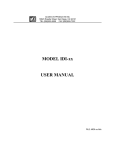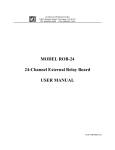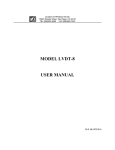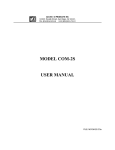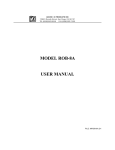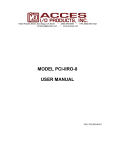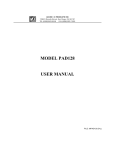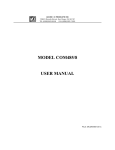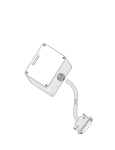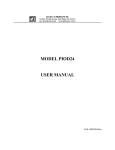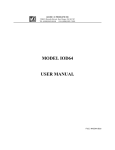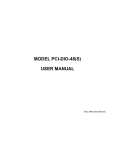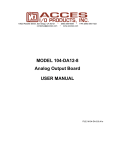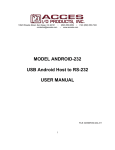Download Manual - ACCES I/O Products
Transcript
10623 Roselle Street, San Diego, CA 92121 C (858) 550-9559 C Fax (858) 550-7322 [email protected] C www.accesio.com MODELS IDO-48, IDO-32 and IDO-16 16, 32, and 48 CHANNEL ISOLATED SOLID-STATE DIGITAL OUTPUT CARDS USER MANUAL FILE: MIDO-XX.D2 Notice The information in this document is provided for reference only. ACCES does not assume any liability arising out of the application or use of the information or products described herein. This document may contain or reference information and products protected by copyrights or patents and does not convey any license under the patent rights of ACCES, nor the rights of others. IBM PC, PC/XT, and PC/AT are registered trademarks of the International Business Machines Corporation. Printed in USA. Copyright 1995 by ACCES I/O Products Inc, 10623 Roselle Street, San Diego, CA 92121. All rights reserved. Page iii Warranty Prior to shipment, ACCES equipment is thoroughly inspected and tested to applicable specifications. However, should equipment failure occur, ACCES assures its customers that prompt service and support will be available. All equipment originally manufactured by ACCES which is found to be defective will be repaired or replaced subject to the following considerations. Terms and Conditions If a unit is suspected of failure, contact ACCES' Customer Service department. Be prepared to give the unit model number, serial number, and a description of the failure symptom(s). We may suggest some simple tests to confirm the failure. We will assign a Return Material Authorization (RMA) number which must appear on the outer label of the return package. All units/components should be properly packed for handling and returned with freight prepaid to the ACCES designated Service Center, and will be returned to the customer's/user's site freight prepaid and invoiced. Coverage First Three Years: Returned unit/part will be repaired and/or replaced at ACCES option with no charge for labor or parts not excluded by warranty. Warranty commences with equipment shipment. Following Years: Throughout your equipment's lifetime, ACCES stands ready to provide on-site or in-plant service at reasonable rates similar to those of other manufacturers in the industry. Equipment Not Manufactured by ACCES Equipment provided but not manufactured by ACCES is warranted and will be repaired according to the terms and conditions of the respective equipment manufacturer's warranty. General Under this Warranty, liability of ACCES is limited to replacing, repairing or issuing credit (at ACCES discretion) for any products which are proved to be defective during the warranty period. In no case is ACCES liable for consequential or special damage arriving from use or misuse of our product. The customer is responsible for all charges caused by modifications or additions to ACCES equipment not approved in writing by ACCES or, if in ACCES opinion the equipment has been subjected to abnormal use. "Abnormal use" for purposes of this warranty is defined as any use to which the equipment is exposed other than that use specified or intended as evidenced by purchase or sales representation. Other than the above, no other warranty, expressed or implied, shall apply to any and all such equipment furnished or sold by ACCES. Page iv Table of Contents Notice . . . . . . . . . . . . . . . . . . . . . . . . . . . . . . . . . . . . . . . . . . . . . . . . . . . . . . . . . . . . . . iii Warranty . . . . . . . . . . . . . . . . . . . . . . . . . . . . . . . . . . . . . . . . . . . . . . . . . . . . . . . . . . . iv Chapter 1: Introduction . . . . . . . . . . . . . . . . . . . . . . . . . . . . . . . . . . . . . . . . . . . . . . 1-1 Description . . . . . . . . . . . . . . . . . . . . . . . . . . . . . . . . . . . . . . . . . . . . . . . . . . . . . . . . . . . . 1-1 Specifications . . . . . . . . . . . . . . . . . . . . . . . . . . . . . . . . . . . . . . . . . . . . . . . . . . . . . . . . . . 1-2 Software . . . . . . . . . . . . . . . . . . . . . . . . . . . . . . . . . . . . . . . . . . . . . . . . . . . . . . . . . . . . . . 1-5 Chapter 2: Installation . . . . . . . . . . . . . . . . . . . . . . . . . . . . . . . . . . . . . . . . . . . . . . 2-1 CD Installation . . . . . . . . . . . . . . . . . . . . . . . . . . . . . . . . . . . . . . . . . . . . . . . . . . . . . . . . . 3.5-Inch Diskette Installation . . . . . . . . . . . . . . . . . . . . . . . . . . . . . . . . . . . . . . . . . . . . . . Directories Created on the Hard Disk . . . . . . . . . . . . . . . . . . . . . . . . . . . . . . . . . . . . . . . . Installing the Card . . . . . . . . . . . . . . . . . . . . . . . . . . . . . . . . . . . . . . . . . . . . . . . . . . . . . . . 2-1 2-1 2-2 2-4 Chapter 3: Address Selection . . . . . . . . . . . . . . . . . . . . . . . . . . . . . . . . . . . . . . . . . 3-1 Setting the Address . . . . . . . . . . . . . . . . . . . . . . . . . . . . . . . . . . . . . . . . . . . . . . . . . . . . . 3-2 Chapter 4: Software . . . . . . . . . . . . . . . . . . . . . . . . . . . . . . . . . . . . . . . . . . . . . . . . . 4-1 Chapter 5: Programming . . . . . . . . . . . . . . . . . . . . . . . . . . . . . . . . . . . . . . . . . . . . . 5-1 Chapter 6: Connector Pin Assignments . . . . . . . . . . . . . . . . . . . . . . . . . . . . . . . . 6-1 Page v List of Figures Figure 1-1: IDO-48 Block Diagram . . . . . . . . . . . . . . . . . . . . . . . . . . . . . . . . . . . . . . . . . . . . 1-3 List of Tables Table 3-1: Standard Address Assignments for 286/386/486 Computers . . . . . . . . . . . . . . . 3-1 Table 5-1: Address Selection Table . . . . . . . . . . . . . . . . . . . . . . . . . . . . . . . . . . . . . . . . . . . 5-1 Table 6-1: Connector Pin Assignments . . . . . . . . . . . . . . . . . . . . . . . . . . . . . . . . . . . . . . . . . 6-1 Page vi Chapter 1: Introduction Features • • • • • • • Individually-Isolated Digital Outputs for up to Three 16-Bit Groups. All solid-state design permits higher throughput than possible with electromechanical relays. Load voltages up to 60 Volts. On-Card shields prevent accidental contact with user voltages. Outputs at zero volts at power turn-on and computer reset. Output connectors via on-card ribbon-cable headers. Lower cost per point than externally-racked solid-state relay modules. Description IDO-xx Series cards provide 16, 32, or 48 opto-isolated differential outputs and plug into expansion slots of IBM PC/XT/AT or compatible computers. Solid-state, P-Channel FET switches are used as the output elements and provide both greater reliability and much faster turn-on and turn-off time than is possible with electromechanical relays. User-supplied load voltages can be from 5V to 60V. Output connections are via 50-wire ribbon cables that mate with one, two, or three headers on the card silk-screen labeled “Port A, Port B, and Port C”. Please note that Port A is also referred to in this manual and in the software as Port 0, Port B as Port 1, and Port C as Port 2 (see table below for correlation). A strain relief bar where the cables exit the card assures that the cables will not interfere with adjacent cards. Standard cables are six feet long but alternate lengths are available. Model STA-50 Screw Terminal Accessory cards, one per each 16 bits, can be used to provide easy connection to your system. The card uses eight bytes of I/O Bus address; six bytes for 48 bits of output, one control byte and one unused byte. Outputs of a programmable array logic chip enable data bytes to be clocked into latches. Outputs of the latches, in turn, are connected via opto-couplers to the output P-channel FET drivers. The opto-couplers used are rated to at least 2000 VRMS and on-card isolation channel-to-channel and channel-to-computer exceeds 500 VRMS in optimal test environments (* see note). The P-Channel FET drivers are capable of 1 Ampere steady-state current (Note: Current output may be limited by the cable to as little as 0.5A). Diodes are included across the load for inductive-spike protection. *Note on Isolation: The Opto-isolators used are rated to at least 2000 VRMS. On-card isolation channel-to-channel and channel-to-ground is governed by factors such as cabling, spacing of pins, spacing between traces on the PCB, humidity, dust, and other environmental factors. This is a safety issue so a careful approach is required. For CE certification, isolation was specified at 60 VDC. The design intention was to eliminate the influence of common mode. Tolerance of higher isolation voltage can be obtained on request by applying a conformal coating to the board. Manual MIDO-XX.D1 Page 1-1 IDO-XX Manual There are 48-bit, 32-bit, and 16-bit versions. The latter two models are de-populated versions of the 48-bit card. Page 1-2 Model No. of Bits Port(s) IDO-16 16 A/0 IDO-32 32 A/0, B/1 IDO-48 48 A/0, B/1, C/2 Manual MIDO-XX.D1 Specifications Features • • • • • • • Individually-Isolated Digital Outputs for Up to Three 16-Bit Groups. All Solid-State Design Permits Higher Throughput Than Possible With Electromechanical Relays. Load Voltages Up to 60V. Outputs Off at Power Turn-On and at Computer Reset. Output Connections via On-Card Ribbon-Cable Headers. On-Card Shields Prevent Accidental User Contact with Load Voltages. Lower Cost per Point Than Externally-Racked Solid-State Relay Modules. Outputs • • • • • • • • • Number of Channels: Load Voltage Range: Load Current per Channel: 16, 32, or 48. 5V to 60V (Voltage supplied by User). 1 Ampere max. steady state, 2A pulse. (Note: Current may be limited by the cable. Certain ribbon cables limit current to 0.5 A.) Isolation: Optically isolated channel to channel and channel to ground (* see note) Opto-isolater: P/N ILQ2 exceeds 2000 VRMS Switching Time: Turn-On: 50 :sec. Turn-Off: 2 :sec, inductive-spike protection via a diode. Switch Resistance: 0.4 S when saturated. Switch Leakage Current: 1 :A. Power Required: +5 VDC at 540 mA (48 bits) Size: 13.3" long (338 mm). *Note on Isolation: The Opto-isolators used are rated to at least 2000 VRMS. On-card isolation channel-to-channel and channel-to-ground is governed by factors such as cabling, spacing of pins, spacing between traces on the PCB, humidity, dust, and other environmental factors. This is a safety issue so a careful approach is required. For CE certification, isolation was specified at 60 VDC. The design intention was to eliminate the influence of common mode. Tolerance of higher isolation voltage can be obtained on request by applying a conformal coating to the board. Environmental • • • Operating Temperature Range: 0°C to 60°C Storage Temperature Range: -20°C to +100°C Humidity: 0% to 90% RH without condensation. Manual MIDO-XX.D1 Page 1-3 IDO-XX Manual Figure 1-1: IDO-48 Block Diagram Page 1-4 Manual MIDO-XX.D1 Each bit controls a single power FET to switch an externally supplied voltage between the supply pin and the return as illustrated by the example circuit below: Each bit of the IDO- card is optically-isolated from the output driver which switches the supply voltage to the output pin. The negative connection is made on the return pin and each output is isolated from every other output. When the opto-isolator is OFF the FET is activated by the Zener-diode-limited supply voltage. When the FET is ON, the full Supply voltage is available at the output pin. When the opto-isolator is deactivated, the FET opens and the output drops to the return line voltage level. The opto-couplers used are rated to at least 2000 VRMS and on-card isolation channel-to-channel and channel-to-computer exceeds 500 VRMS in optimal test environments (* see isolation note). (Note: Ribbon cables typically provide 300 VRMS isolation.) The P-Channel FET drivers are capable of 1 Ampere steady-state current (Note: Current output may be limited by the cable to as little as 0.5A). Diodes are included across the load for inductive-spike protection. Safety Note • • • • These cards are used as switches for externally supplied power up to 60VDC and up to one Amp. Each switch output can have a separate power supply or only one power supply can be used. If the computer is turned OFF and an external power supply is ON, the switch outputs from that power supply will be ON. To avoid damage or injury, you MUST turn OFF all the external power PRIOR to shutting the computer down. Manual MIDO-XX.D1 Page 1-5 IDO-XX Manual Software Utility software provided with IDO- Series cards includes a graphic setup program to aid in selecting an I/O-bus address that will not conflict with other computer resources. Also, a pictorial presentation shows you what switch settings to make for the base address that you select. Software drivers are not provided for DOS applications because direct register I/O is the fastest way to communicate and can be used with ease. Most high level languages provide means for output statements and our User Manual provides complete details about register assignments. Further, sample programs are provided in C, Pascal, and QuickBASIC. For Windows users, we provide drivers for Windows 3.1, Win 95 and Win NT. Page 1-6 Manual MIDO-XX.D1 Manual MIDO-XX.D1 Page 1-7 Chapter 2: Installation The software provided with this card is contained on either one CD or multiple diskettes and must be installed onto your hard disk prior to use. To do this, perform the following steps as appropriate for your software format and operating system. Substitute the appropriate drive letter for your CD-ROM or disk drive where you see d: or a: respectively in the examples below. CD Installation DOS/WIN3.x 1. 2. 3. 4. Place the CD into your CD-ROM drive. Type B- to change the active drive to the CD-ROM drive. Type GLQR?JJ- to run the install program. Follow the on-screen prompts to install the software for this card. a. b. Place the CD into your CD-ROM drive. The CD should automatically run the install program after 30 seconds. If the install program does not run, click START | RUN and type d:install, click OK or press -. Follow the on-screen prompts to install the software for this card. WIN95/98/NT c. Directories Created on the Hard Disk The installation process will create several directories on your hard disk. If you accept the installation defaults, the following structure will exist. [CARDNAME] Root or base directory containing the SETUP.EXE setup program used to help you configure jumpers and calibrate the card. DOS\PSAMPLES:A subdirectory of [CARDNAME] that contains Pascal samples. DOS\CSAMPLES:A subdirectory of [CARDNAME] that contains "C" samples. Win32\language:Subdirectories containing samples for Win95/98 and NT. WinRisc.exe A Windows dumb-terminal type communication program designed for RS422/485 operation. Used primarily with Remote Data Acquisition Pods and our RS422/485 serial communication product line. Can be used to say hello to an installed modem. ACCES32 This directory contains the Windows 95/98/NT driver used to provide access to the hardware registers when writing 32-bit Windows software. Several samples are provided in a variety of languages to demonstrate how to use this driver. The DLL provides four functions (InPortB, OutPortB, InPort, and OutPort) to access the hardware. Manual MIDO-XX.D1 Page 2-1 IDO-XX Manual This directory also contains the device driver for Windows NT, ACCESNT.SYS. This device driver provides register-level hardware access in Windows NT. Two methods of using the driver are available, through ACCES32.DLL (recommended) and through the DeviceIOControl handles provided by ACCESNT.SYS (slightly faster). Page 2-2 Manual MIDO-XX.D1 SAMPLES Samples for using ACCES32.DLL are provided in this directory. Using this DLL not only makes the hardware programming easier (MUCH easier), but also one source file can be used for both Windows 95/98 and WindowsNT. One executable can run under both operating systems and still have full access to the hardware registers. The DLL is used exactly like any other DLL, so it is compatible with any language capable of using 32-bit DLLs. Consult the manuals provided with your language's compiler for information on using DLLs in your specific environment. VBACCES This directory contains sixteen-bit DLL drivers for use with VisualBASIC 3.0 and Windows 3.1 only. These drivers provide four functions, similar to the ACCES32.DLL. However, this DLL is only compatible with 16-bit executables. Migration from 16-bit to 32-bit is simplified because of the similarity between VBACCES and ACCES32. PCI This directory contains PCI-bus specific programs and information. If you are not using a PCI card, this directory will not be installed. SOURCE A utility program is provided with source code you can use to determine allocated resources at run-time from your own programs in DOS. PCIFind.exe A utility for DOS and Windows to determine what base addresses and IRQs are allocated to installed PCI cards. This program runs two versions, depending on the operating system. Windows 95/98/NT displays a GUI interface, and modifies the registry. When run from DOS or Windows3.x, a text interface is used. For information about the format of the registry key, consult the card-specific samples provided with the hardware. In Windows NT, NTioPCI.SYS runs each time the computer is booted, thereby refreshing the registry as PCI hardware is added or removed. In Windows 95/98/NT PCIFind.EXE places itself in the boot-sequence of the OS to refresh the registry on each power-up. This program also provides some COM configuration when used with PCI COM ports. Specifically, it will configure compatible COM cards for IRQ sharing and multiple port issues. WIN32IRQ This directory provides a generic interface for IRQ handling in Windows 95/98/NT. Source code is provided for the driver, greatly simplifying the creation of custom drivers for specific needs. Samples are provided to demonstrate the use of the generic driver. Note that the use of IRQs in near-real-time data acquisition programs requires multi-threaded application programming techniques and must be considered an intermediate to advanced programming topic. Delphi, C++ Builder, and Visual C++ samples are provided. Manual MIDO-XX.D1 Page 2-3 IDO-XX Manual Findbase.exe DOS utility to determine an available base address for ISA bus , non-Plug-n-Play cards. Run this program once, before the hardware is installed in the computer, to determine an available address to give the card. Once the address has been determined, run the setup program provided with the hardware to see instructions on setting the address switch and various option selections. Poly.exe A generic utility to convert a table of data into an nth order polynomial. Useful for calculating linearization polynomial coefficients for thermocouples and other non-linear sensors. Risc.bat A batch file demonstrating the command line parameters of RISCTerm.exe. RISCTerm.exe A dumb-terminal type communication program designed for RS422/485 operation. Used primarily with Remote Data Acquisition Pods and our RS422/485 serial communication product line. Can be used to say hello to an installed modem. RISCTerm stands for Really Incredibly Simple Communications TERMinal. Installing the Card Before installing the card, carefully read the Address Selection and Option Selection chapters of this manual and configure the card according to your requirements. Use the special software program called SETUP provided on CD with the card. It supplies visual aids to configure all areas of the card. Be especially careful with address selection. If the addresses of two installed functions overlap, you will experience unpredictable computer behavior. If unsure what locations are available, you can use the FINDBASE program provided on our Cd to locate blocks of available addresses. To Install the Card 1. 2. 3. 4. 5. 6. 7. 8. 9. 10. Page 2-4 Remove power from the computer. Remove the computer cover. Remove blank I/O backplate. Select the base address on the card. See Address Selection Loosen the nuts on the strain relief bar and swing top end free Install the card in an I/O expansion slot. If convenient, select a slot adjacent to a vacant slot because this will make cable installation easier, and allow clearance for the high-voltage insulating shields that ship installed onto the card. Thread the I/O cables, one by one, through the cutout in the mounting bracket and plug them into the headers. Smooth the cables as close as possible to the card and, while holding them close to the surface of the card, swing the strain relief bar into position and tighten nuts. Inspect for proper fit of the card and cables and tighten screws. Replace the computer cover. Manual MIDO-XX.D1 Warning This card can be used with signals that contain very high common mode voltages. For safety, the cables should not be connected to the sources of these signals when installing or removing connections to the card. Further, to assure that the cables aren't pinched by the strain relief bar, it is good safety practice to enclose the cables in a protective jacket. PVC protective jacketing is available that meets UL, CSA, and MIL specifications. Safety Notes These cards are used mostly as switches for externally supplied power up to 60 VDC and up to one Ampere. If the computer is turned OFF and that external power is still applied to the card, all the output lines will be turned ON. To avoid damage or injury, you MUST turn OFF the external power when the computer is turned OFF. The board ships with high-voltage insulating shields installed to protect adjacent cards and/or conductors inside the computer chassis from inadvertent contact with the external power supply voltage. EMC / EMI / CE Note Input/Output connections are via 50-pin header(s) on the card. A blank mounting bracket is provided with units marked for CE (European) Certification and, for these units, CE-certifiable cable and break-out methodology (cables connected to ground at the aperture, twisted pair wiring, etc.) must be used. Also, it is important that the card mounting bracket be properly screwed into place and that there be a positive chassis ground. Manual MIDO-XX.D1 Page 2-5 IDO-XX Manual Page 2-6 Manual MIDO-XX.D1 Chapter 3: Address Selection The IDO-48 card occupies eight bytes of I/O space. The card base address can be selected anywhere within the I/O address range 100-3F0 hex except 1F0 to 1F8. However two installed options cannot share the same address. If in doubt where to assign the base address, refer to the following tables and the FINDBASE program to find an available address for your system. Hex Range Usage 000-01F DMA Controller 1 020-03F INT Controller 1, Master 040-05F Timer 060-06F 8042 (Keyboard) 070-07F Real Time Clock, NMI Mask 080-09F DMA Page Register 0A0-0BF INT Controller 2 0C0-0DF DMA Controller 2 0F0 Clear Math Coprocessor Busy 0F1 Reset Coprocessor 0F8-0FF Arithmetic Processor 1F0-1F8 Fixed Disk 200-207 Game I/O 278-27F Parallel Printer Port 2 2F8-2FF Asynchronous Comm'n (Secondary) 300-31F Prototype Card 360-36F Reserved 378-37F Parallel Printer Port 1 380-38F SDLC or Binary Synchronous Comm'n 2 3A0-3AF Binary Synchronous Comm'n 1 3B0-3BF Monochrome Display/Printer 3C0-3CE Local Area Network 3D0-3DF Color/Graphic Monitor 3F0-3F7 Floppy Diskette Controller 3F8-3FF Asynchronous Comm'n (Primary) Table 3-1: Standard Address Assignments for 286/386/486 Computers Manual MIDO-XX.D1 Page 3-1 IDO-XX Manual Setting the Address To set desired board address, refer to the illustrated Board Address setup program on the CD provided with the card. Type the desired address in hexadecimal code and the graphic display shows you how to set the Address Setup switches. These switches are marked A3-A9 and form a binary representation of the address in negative-true logic. (assign '0' to all Address Setup switches turned ON, and assign '1' to all Address Setup switches turned OFF.) Switch Identification A9 A8 A7 A6 A5 A4 A3 Address Line Controlled A9 A8 A7 A6 A5 A4 A3 The following example illustrates switch selection corresponding to hex 2D8 (or binary10 11011xxx). The "xxx" represents address lines A2, A1, and A0 used on the card to select individual inputs. See Chapter 5, Programming. 2 Hex Representation D 8 Conversion Multipliers 2 1 8 4 2 1 8 Binary Representation 1 0 1 1 0 1 1 Set Up OFF ON OFF OFF ON OFF OFF Switch ID A9 A8 A7 A6 A5 A4 A3 Caution Carefully review the address selection reference table on the previous page before selecting the card address. If the addresses of two installed functions overlap you will experience unpredictable computer behavior. Page 3-2 Manual MIDO-XX.D1 Chapter 4: Software There are sample programs provided with the IDO-xx card in C, Pascal, QuickBASIC, and several Windows languages. DOS samples are located in the DOS directory and Windows samples are located in the WIN32 directory. Manual MIDO-XX.D1 Page 4-1 IDO-XX Manual Page 4-2 Manual MIDO-XX.D1 Chapter 5: Programming IDO- Series cards are I/O-mapped devices that are easily configured from any language and any language can easily control digital outputs through the card's ports. This is especially true if the form of the data is byte or word wide. All references to the I/O ports would be in absolute port addressing. However, a table could be used to convert the byte or word data ports to a logical reference. A total of eight address locations are occupied by the IDO-48. Register locations are listed in the following table. Address Write Read* Base Address Port A/0 Bits 0-7 Port A/0 Bits 0-7 Base Address +1 Port A/0 Bits 8-15 Port A/0 Bits 8-15 Base Address +2 Port B/1 Bits 0-7 Port B/1 Bits 0-7 Base Address +3 Port B/1 Bits 8-15 Port B/1 Bits 8-15 Base Address +4 Port C/2 Bits 0-7 Port C/2 Bits 0-7 Base Address +5 Port C/2 Bits 8-15 Port C/2 Bits 8-15 Base Address +6 reserved reserved Base Address +7 Control Byte Control Byte Table 5-1: Address Selection Table Bit 7/15 D7 Bit 6/14 D6 Bit 5/13 D5 Bit 4/12 D4 Bit 3/11 D3 Bit 2/10 D2 Bit 1/9 D1 Bit 0/8 D0 Writing a byte to Port n address activates each output with a “1” at the bit location, deactivates each output with a “0” at the bit. Reading a byte from Port n address displays a “1” for each output that is active, and displays a “0” for each output that is inactive. * (See Control Byte description below for instructions to enable this function) The Control Byte enables / disables the read-back function of all Ports. To enable read-back capability, write 9Bh to Base Address +7. Reading from Base Address +7 will then return 9Bh. To disable read-back write 80h to Base Address +7. Reading from Base Address +7 will then return 80h. The Power On/Default state is read-back disabled. Manual MIDO-XX.D1 Page 5-1 IDO-XX Manual Page 5-2 Manual MIDO-XX.D1 Chapter 6: Connector Pin Assignments Three identical 50-pin headers are provided on the IDO-48; one for each 16-bit output group. Port A is closest to the card mounting bracket, while Port C is furthest from it. The mating connector is an AMP type 1-746285-0 or equivalent. Connector pin assignments are listed below. Pin Signal Pin Signal 1 Ground 2 Bit 0 Return 3 Bit 0 Out 4 Bit 0 Supply 5 Bit 1 Return 6 Bit 1 Out 7 Bit 1 Supply 8 Bit 2 Return 9 Bit 2 Out 10 Bit 2 Supply 11 Bit 3 Return 12 Bit 3 Out 13 Bit 3 Supply 14 Bit 4 Return 15 Bit 4 Out 16 Bit 4 Supply 17 Bit 5 Return 18 Bit 5 Out 19 Bit 5 Supply 20 Bit 6 Return 21 Bit 6 Out 22 Bit 6 Supply 23 Bit 7 Return 24 Bit 7 Out 25 Bit 7 Supply 26 Bit 8 Return 27 Bit 8 Out 28 Bit 8 Supply 29 Bit 9 Return 30 Bit 9 Out 31 Bit 9 Supply 32 Bit 10 Return 33 Bit 10 Out 34 Bit 10 Supply 35 Bit 11 Return 36 Bit 11 Out 37 Bit 11 Supply 38 Bit 12 Return 39 Bit 12 Out 40 Bit 12 Supply 41 Bit 13 Return 42 Bit 13 Out 43 Bit 13 Supply 44 Bit 14 Return 45 Bit 14 Out 46 Bit 14 Supply 47 Bit 15 Return 48 Bit 15 Out 49 Bit 15 Supply 50 Ground Table 6-1: Connector Pin Assignments Manual MIDO-XX.D1 Page 6-1 IDO-XX Manual Page 6-2 Manual MIDO-XX.D1 Customer Comments If you experience any problems with this manual or just want to give us some feedback, please email us at: [email protected].. Please detail any errors you find and include your mailing address so that we can send you any manual updates. 10623 Roselle Street, San Diego CA 92121 Tel. (858)550-9559 FAX (619)550-7322 www.accesio.com




























